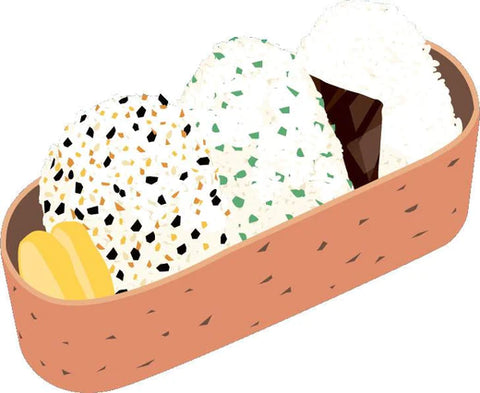1. Preparing Bento Box
Ways to Sterilize a Bento Box
- If it’s dishwasher safe, use a high heat cycle OR
- Wipe down with diluted bleach solution OR
- Wipe down with a diluted vinegar solution

2. Cooking
Don’t Touch Food Directly with Bare Hands
Of course before preparing food you’ll wash your hands, but there will remain some bacteria. It is better to use tools such as chopsticks and spoons, and not to touch food directly with your bare hands.When making onigiri, please use plastic wrap as a barrier while forming the rice into balls. Also, salting the surface of onigiri will prevent bacterial growth.
Add Vinegar to the Cooking Water
Fresh cooked rice contains a lot of water, making it an easy place for germs to grow. Adding vinegar to the rice cooking water will lower the pH level, making it less hospitable to nasty germs.
1 tbsp vinegar for 2 rice cooker cups of uncooked rice is effective and may add only the slightest vinegary taste. When making sushi rice, vinegar, along with sugar and salt will be mixed in the with the rice AFTER it is cooked for the same purpose.
Use Salt to Keep Food Safe
Salt has an antibacterial and sterilization function. It is not healthy to consume too much salt, but for a bento box, it is better to put a little bit more salt than you usually would. Of course do not season the meal to the point of ruining it.
Make the Dishes in the Bento as Dry as Possible
The presence of water plays a role in the growth of germs. When you cook watery dishes, make it as dry as possible. For example, when you cook nimono (a stewed vegetable dish), you can cook it until almost all the water has evaporated.
If your bento includes soy sauce or dressing, put it in a separate container and add it to the food right before eating.
Reheat Leftover Food
It is not ok to put any food in bento box in the morning from last night. It is always better and safer if you reheat the food in the morning. Leftovers should be reheated for at least 1 minute at 75°C/167°F or greater.
3. Ingredients with Antibacterial Properties
Umeboshi (Japanese Pickled Plum)
Umeboshi contains a lot of citric acid and has a strong antibacterial function.
When you use umeboshi, it is better to break it up and cover as much surface area of the food as possible. Hinomaru bento (Hinomaru is the red sun on a white background of the Japanese national flag) is a famous, and very minimalist, bento consisting simply of white rice with a red umeboshi in the center. For sanitary reasons, it is better to chop up the umeboshi and mix it in with the rice, rather than using the Hinomaru design.

Vinegar
Vinegar also has strong antibacterial and sterilizing powers. As with umeboshi, it is most effective if it is spread around and mix with food.
Ginger
When cooked, ginger produces the compounds shogaol and gingerol which have a number of health benefits, and are said to kill germs. Mixed with ingredients that tend to go bad quickly, ginger will help preserve it. Ginger also helps build an appetite, making it a good thing to eat during hot summer months.
Soy Sauce
Lactic acid, salt, a low pH level, and alcohol in soy sauce all help to preserve food.
Shiso
Shiso is a relative of mint and basil and is commonly used in Japanese cooking. It contains beryl aldehyde which has strong sterilizing capabilities.
Red shiso contains anthocyanin which has an antioxidative effect.




